
Cardiff city centre is the city centre and central business district of Cardiff, Wales. The area is tightly bound by the River Taff to the west, the Civic Centre to the north and railway lines and two railway stations – Central and Queen Street – to the south and east respectively. Cardiff became a city in 1905.

Liverpool Philharmonic Hall is a concert hall in Hope Street, in Liverpool, England. It is the home of the Royal Liverpool Philharmonic Society and is recorded in the National Heritage List for England as a designated Grade II* listed building. It is not the original concert hall on the present site; its predecessor was destroyed by fire in 1933 and the present hall was opened in 1939.

St Luke's Church, more commonly known by locals as the bombed-out church, is a former Anglican parish church in Liverpool, England. It stands on the corner of Berry Street and Leece Street, at the top of Bold Street.
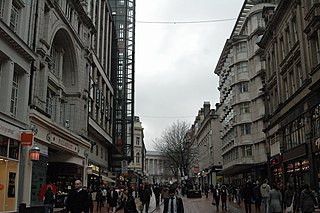
New Street is a street in central Birmingham, England. It is one of the city's principal thoroughfares and shopping streets linking Victoria Square to the Bullring Shopping Centre. It gives its name to New Street railway station, although the station has never had direct access to New Street except via Stephenson Place and latterly Grand Central shopping centre.
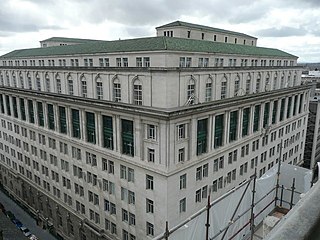
India Buildings is a commercial building with its principal entrance in Water Street, Liverpool, England. Mainly an office building, it also contained an internal shopping arcade and the entrance to an underground station. It was built between 1924 and 1932, damaged by a bomb in 1941, and later restored to its original condition under the supervision of one of its original architects. The building, its design influenced by the Italian Renaissance and incorporating features of the American Beaux-Arts style, occupies an entire block in the city.
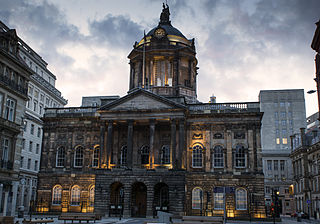
Liverpool Town Hall stands in High Street at its junction with Dale Street, Castle Street, and Water Street in Liverpool, Merseyside, England. It is recorded in the National Heritage List for England as a designated Grade I listed building, and described in the list as "one of the finest surviving 18th-century town halls". The authors of the Buildings of England series refer to its "magnificent scale", and consider it to be "probably the grandest ...suite of civic rooms in the country", and "an outstanding and complete example of late Georgian decoration".
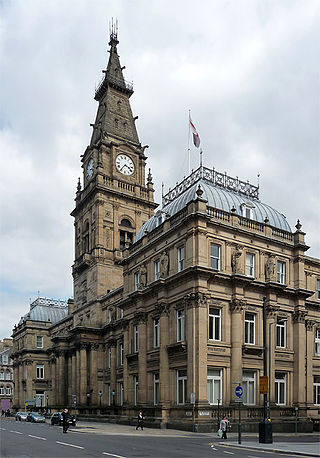
Municipal Buildings is a former council office building that has been converted into a hotel. It is located on Dale Street in the centre of Liverpool, England. It is a Grade II* listed building.

The Aloft Liverpool Hotel, formerly the Royal Insurance Building, is a historic building located at 1-9 North John Street, Liverpool, Merseyside, England. It was built as the head office of the Royal Insurance company.

Piccadilly Gardens is a green space in Manchester city centre, England, on the edge of the Northern Quarter.

Wellington's Column, or the Waterloo Memorial, is a monument to the Duke of Wellington standing on the corner of William Brown Street and Lime Street, Liverpool, Merseyside, England. It is recorded in the National Heritage List for England as a designated Grade II* listed building.

Portsmouth Guildhall is a multi-use building in the centre of Portsmouth, Hampshire, England. It is located in a pedestrian square close to Portsmouth and Southsea railway station. Constructed in 1890, the building was known as Portsmouth Town Hall until 1926. It was heavily damaged by bombing during the Second World War and largely rebuilt during the 1950s by the English architect Ernest Berry Webber. It now operates as a concert, wedding and conference venue. It is a Grade II listed building.
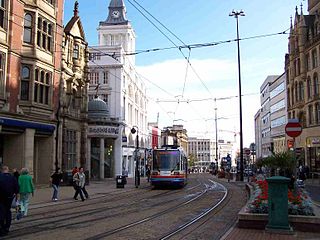
High Street is one of the main thoroughfares and shopping areas in the city centre of Sheffield in South Yorkshire, England, located at the approximate grid reference of SK356874. High Street starts at the Commercial Street, Fitzalan Square and Haymarket junction and runs for approximately 400 metres west to conclude near the Sheffield Cathedral where it forms a Y-junction with Fargate and Church Street. High Street has the traditional wide variety of shops, financial institutions and eating places which are associated with any British town centre.

Cheltenham Town Hall is an early-20th century assembly rooms in Cheltenham, England. Unlike most town halls, it is a public venue and not the seat of the borough council, which is housed in the nearby Municipal Offices. It is a Grade II listed building.
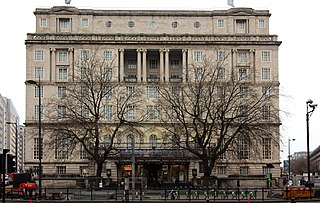
The Britannia Adelphi Hotel is in Ranelagh Place, Liverpool city centre, Merseyside, England. The present building is the third hotel on the site, and is recorded in the National Heritage List for England as a designated Grade II listed building. The building is owned and managed by Britannia Hotels. It contains 402 en-suite bedrooms, conference and dining facilities, and a gymnasium.

The architecture of Liverpool is rooted in the city's development into a major port of the British Empire. It encompasses a variety of architectural styles of the past 300 years, while next to nothing remains of its medieval structures which would have dated back as far as the 13th century. Erected 1716–18, Bluecoat Chambers is supposed to be the oldest surviving building in central Liverpool.
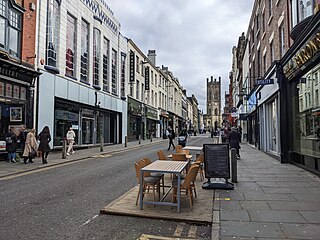
RopeWalks is a district of Liverpool city centre bounded by Hanover Street to the north-west, Lydia Ann Street to the west, Roscoe Street to the east and Back Bold Street to north-east.
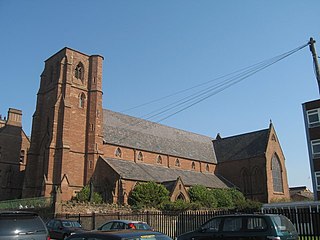
St Anne's Church is in Overbury Street, Edge Hill, Liverpool, Merseyside, England. It is an active Roman Catholic parish church in the Archdiocese of Liverpool. In 1999 its parish was combined with that of the Church of St Bernard. The church is recorded in the National Heritage List for England as a designated Grade II listed building.

Southport Arts Centre, formerly known as Cambridge Hall, is on the east side of Lord Street, Southport, Sefton, Merseyside, England, and stands between Southport Town Hall and the Atkinson Art Gallery and Library. It was built in 1873–74 and originally contained an assembly hall. The centre contains mixed architectural styles and has a tall clock tower at the right end. During the 20th century the assembly hall was converted into a theatre, and it forms part of the arts complex known as The Atkinson. The arts centre is recorded in the National Heritage List for England as a designated Grade II listed building.
The city of Liverpool in Merseyside, England includes a diverse variety of historical housing architectures, some dating back several hundred years, from small working class terrace houses to larger mansions, mostly from the Victorian era. While many remain in the present day, large numbers were demolished and redeveloped during the slum clearances of the 1960s and 1970s and of those that survived, many have since been refurbished.

St. John's Market was a municipal retail market hall in Liverpool, England, housed in a purpose-designed building erected between 1820 and 1822 to a design by John Foster, Junior. It quickly came to be seen as a model for market halls erected elsewhere in the UK in the 19th century. The north and south facades of the building were altered in 1881 and 1891; it was demolished in 1964, making way for the 1969 St Johns Shopping Centre, the western half of which occupies the hall's site.




















